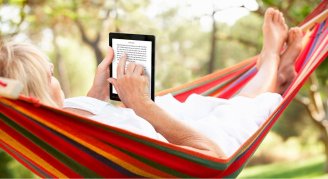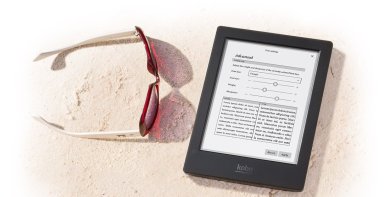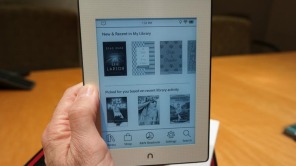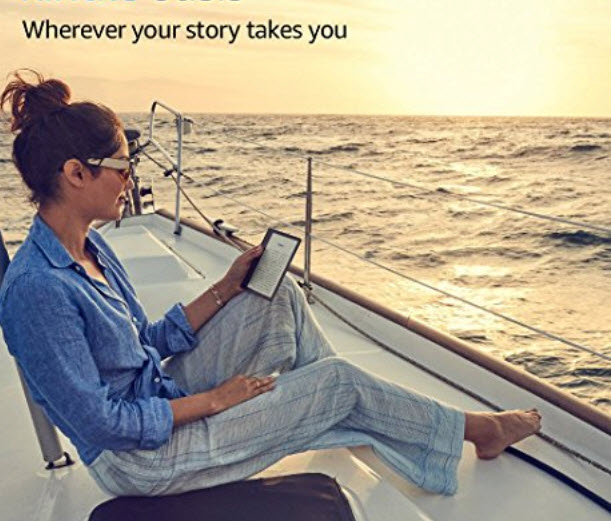By Alan Cairns
Read poolside, at the beach, or in the bathtub? Tempted to buy the new waterproof Amazon Kindle Oasis with a seven-inch screen?
Maybe you should. But first read this.
Competitors like Kobo and Nook have offered waterproof e-readers for years. Amazon is the one catching up here despite other new wrinkles.
Ahead we’ll compare the new Oasis with three other waterproof e-readers, and you’ll also learn about waterproof cases, including ones for the older six-inch Oasis.
Kindle Oasis 7″ model
The “all-new” seven-inch Kindle Oasis carries an IPX8 waterproof rating, which means it has been tested in at least a meter of water and in hot tubs, pools, and bathtubs. See our previous posts on the seven incher’s introduction and a test dunk that the Kindle Chronicles‘s Len Edgerly gave the new model in the Atlantic Ocean.
Building on the success of the previous Oasis, the seven incher can fit 30 percent more words on its brighter 300 dpi screen. It also has a larger battery than the previous Oasis and retains physical page-turning buttons. Prices start at $250.
This it the first Kindle with built-in Audible app installation, and firmware upgrades “in the coming months” will make Audible available for the older Oasis and other eighth-generation Kindles.
You can stream audiobooks and blind-optimized text-to-speech audio to headphones or speakers via bluetooth (the TTS interface is a mess for the sighted). Owners of Amazon’s smart speaker Echos can switch seamlessly between ebook and audiobook titles.
The new Oasis is designed for one-handed reading, with one wafer-thin 3.4mm tapered edge. Just as with the Kindle Voyage, the device’s brightness responds to ambient light for optimal reading in all environments.
Content customization features include more font sizes, adjustable bold levels, and a left-align function. The good news for other Kindle users is that these features are also available as software updates for Kindle Paperwhite 2013 devices and up.
The latest Oasis also offers additional accessibility features including the ability to invert page colours (black on white / white on black) and zoom in on navigational menus.
It comes in 8GB and 32GB models.
Optional is a free 3G connection with an upgraded 32GB version. The 3G connection is available in 100 countries around the world, and means users can download books on the move. The Oasis with 3G is retailing for about $350.
How does it compare with other waterproof e-readers?
Kobo Aura One
 The Kobo Aura One has the same IPX8 waterproof rating as the latest Oasis. It is one of the bigger e-readers on the market with a 7.8 inch screen. The Aura One came out in 2016, when all Kindles had six-inch screens, and Amazon appeared to have followed suit with the new seven-inch Oasis (still a little smaller).
The Kobo Aura One has the same IPX8 waterproof rating as the latest Oasis. It is one of the bigger e-readers on the market with a 7.8 inch screen. The Aura One came out in 2016, when all Kindles had six-inch screens, and Amazon appeared to have followed suit with the new seven-inch Oasis (still a little smaller).
The $230 Aura One is almost the same size as an iPad Mini 4 and sells for $20 less than the basic model of the new Oasis.
Kobo’s ComfortLightPro technology – similar to NightShift on iPhones and iPads or f.lux on desktop computers – means the Aura One screen starts the day with a blue hue and slowly switches to more yellow and orange hues towards the end of the day. Research shows that this helps to aid sleep after screen use – good news for bedtime readers.
The device is very thin at 6.9mm, as the components have been spread thinly over its 195.1 x 138.5mm chassis. The screen is 300ppi with a resolution of 1872 x 1404. It has 8GB of storage and 512Mb of RAM.
Kobo also recently announced a new 32GB Aura One storage option to compete with Amazon’s new Kindle Oasis. The limited edition e-reader goes on sale on December 6 for $280.
Kobo Aura H2O 2017
 The Aura H20 2017 is Kobo’s more compact waterproof e-reader. At $160 it’s a mid-priced e-reader both in terms of Kobo’s product line and the marketplace overall.
The Aura H20 2017 is Kobo’s more compact waterproof e-reader. At $160 it’s a mid-priced e-reader both in terms of Kobo’s product line and the marketplace overall.
Just like the Aura One and Kindle Oasis 7, the Aura H20 has an IPX8 waterproof rating. Its 6.8 inch screen offers the same ComfortLightPro dynamic backlighting technology as the Aura One’s screen. The 265ppi 1440 x 1080 resolution screen is slightly lower resolution than the Amazon Kindle Oasis.
The device is smaller and lighter than the Aura One, at 210g, a similar weight to the seven-inch Oasis. It’s thicker than than both at 10mm. The battery is estimated to last 30 hours with WiFi and ComfortLightPro turned off, and includes several battery saving functions. The device offers customisable text sizes and fonts, including a dyslexia-friendly font, and 8GB of storage. As with the new Kindles, you can easily adjust how bold the words and letters are.
Nook GlowLight Plus
 The Nook GlowLight Plus by Barnes & Noble comes with a slightly lower level of waterproof certification than the other e-readers covered here – IP67. That means the Plus has been tested in fresh water for 30 minutes at 3.28 feet. Unless you’re interested in underwater reading, the Plus is still reassuringly waterproof.
The Nook GlowLight Plus by Barnes & Noble comes with a slightly lower level of waterproof certification than the other e-readers covered here – IP67. That means the Plus has been tested in fresh water for 30 minutes at 3.28 feet. Unless you’re interested in underwater reading, the Plus is still reassuringly waterproof.
The GlowLight Plus has rounded corners and soft touch plastic exterior edged with silicon, giving it a more luxurious feel than many other e-readers, despite being the cheapest e-reader on our list at $120-$130. The Plus is available in the U.S. as a refurb from B&N for just $79.99. B&N might be phasing it out in favor of the $120 Nook GlowLight 3, which, in an online listing, lacks mention of waterproofing. B&N says the GlowLight 3 is to go on sale Wednesday, November 8.
Small at 165 x 127 x 10mm, the Plus is lighter than its predecessor at 175g and its 6-inch screen has a 1024 x 758 resolution with 300 dpi.
One of the most important things to note about the Plus, and all Nook readers, is that they only support the open ePub file standard rather than the .mobi format that Amzaon took over. Also, questions have arisen about the extent of B&N’s long-time commitment to the ebook business.
The Plus is a little lighter on storage, offering just 2.8GB of user accessible storage, but is also had a microSD card slot for more.
Just like the other devices covered here, it has adjustable fonts and font sizes as well as a bookmark feature. Nook can also link with Facebook, Twitter, and Google accounts to allow readers to highlight and share quotations with friends, family, and followers.
Summary
| Kindle Oasis 7 | Aura One | Aura H20 2017 | GlowLight Plus | |
| Screen size | 7” | 7.8” | 6.8” | 6” |
| Resolution | 1680 x 1264 | 1872 x 1404 | 1430 x 1080 | 1430 x 1080 |
| PPI | 300 | 300 | 265 | 300 |
| Size | 159 x 141 mm | 196 x 139 mm | 179 x 129 mm | 163.6 x 119.6 mm |
| Thickness | 8.3 mm | 7mm | 10 mm | 8.6 mm |
| Weight | 194g | 252g | 210g | 175g |
| Storage | 8GB / 32GB | 8GB / 32GB | 8GB | 4GB |
| Battery life (variable) | 21 hours | 15 – 20 hours | 30 hours | 15 hours |
| Waterproof rating | IPX8 | IPX8 | IPX8 | IPX67 |
| Price | $250 / $280 / $350 (Free 3G) | $230 / $280 | $165 | $120 |
Those who are looking for a large, elegant, waterproof e-reader should consider the Kobo Aura. It offers a larger 300ppi screen and is a bit cheaper than the Oasis. It doesn’t offer the Audible app or 3G connection, but it is one of the largest e-readers available and the limited edition 32GB Aura One can store approximately 28,000 books.
Those looking for a cheaper waterproof e-reader could consider the Kobo Aura H20 2017. The screen is almost the same size as the seven-inch Oasis, and this model is almost as light, has a longer battery life, and is significantly cheaper at $165.
Those looking for something smaller, cheaper, and arguably more luxurious in feel should consider the Nook GlowLight Plus as long as they know that B&N’s position in the e-book business is not as solid as Amazon’s. While it’s low on user storage, many people love its feel.
That’s not to say the seven-inch Oasis isn’t worth the money. It’s got some unique features that make it a strong proposition too. But you might not be able to make your decision based strictly on these specifications.
Switching ebook provider
One of the most important about all competing e-readers is that you can’t access Amazon’s ebook store with them. Each provider only offers access to their own book store.
Kobo’s store has five million titles while Barnes & Noble’s has 3 million. Both similar to Amazon’s 5.5 million+ titles, but neither offer the same volume of new releases and special offers. As Amazon’s ebook sales now account for 83 percent of the US market, that seems unlikely to change.
Amazon offer the Unlimited scheme where users can access one million books for a monthly fee. The Kobo Auras One has a similar function with the Overdrive app, allowing users to access to the whole library, but this feature is unavailable on the H2O.
For the time being at least, users can’t transfer their books between Kobo, Nook and Amazon devices. When you switch device you lose your ebooks, unless you stick with the same manufacturer.
Cases and covers
Many of us buy some type of cover for tablets and e-readers. They offer varying levels of protection from things like dust and water. Even the cheapest cover can protect against the risk of damage from a spilled drink, raindrop or tear.
There are two main types of protectors –
Sealed plastic jackets
Transparent plastic cases can offer a good level of waterproofing, depending on the material and how it is sealed. Some of these cases, if properly sealed, can protect an e-reader for up to an hour in two meters of water.
Most of these cases come with universal measurements – 6 inch, 7 inch etc. – but be careful, as similar devices can have very different dimensions.
Heavy duty covers
Heavy duty tablet and e-reader covers tend to be waterproof. Unlike sleeve or jacket-type covers hard cover must be tailored to the device to allow use of ports and buttons. Some of these cases even protect against snow, dust and shock, offering far greater drop protection.
If you already have an e-reader you like, then consider investing in a case that can protect it from water, the outdoors and even droppages. One possibility would be the Redpepper case for the 2012 and 2013 models of the Paperwhite. And if you own an older Oasis without the waterproofing, consider the Vcloo Waterproof case or rivals such as one from iThrough.
Whatever the approach, either factory-waterproofing or otherwise, soggy devices should be a thing of the past.
Alan Cairns is Content Director at Choose.co.uk, a UK consumer site.


Reblogged this on Chris The Story Reading Ape's Blog.
LikeLike
The Nook Glowlight plus has a PPI of 300 according to the data on the BN link you provided.
LikeLike
@Anne: Big thanks. We’ve fixed the glitch.
LikeLike
Great review of what’s new with waterproof e-readers and cases. I may have to upgrade from my dinosaur reader!
LikeLike
Ah, a lot has changed since Jeff Bezos suggested that those who wanted to read their Kindle in a bathtub should get a ziplock bag.
Thanks for a most detailed review. There’s only one thing you forgot to mention… or rather lament. Using any ereader, however, waterproof, in a tub or pool, means tapping its screen or switch with wet fingers, which can leave hard-to-remove mineral deposits on the screen.
What all ereaders need is an ability to use the two buttons on an inexpensive Bluetooth mouse to page forward or back. That’d be cheap to implement. The WiFi chip in them can already do Bluetooth. And it would be great for everyone, particularly the mobility-impaired. Adding a Bluetooth keyboard at the same time would be useful for those who like to take notes. It’s far better than tapping on a screen.
Now that we’re on the topic of more goodies, why not add ereaders to the lists of those calling for FM radios to be built in to digital devices. About 2008, a basic FM radio was added to many WiFi chips. All it needs is to be enabled and provided with an antenna, such as a headphone cord. That’d be great for those who like to listen while reading and it’d mean one less thing to take along for those on vacation. It’d also be a reason to buy one ereader over another.
LikeLike
Maybe… but those features feel as if we are approaching tablet territory. It is something that does not appeal to me but I can see its appeal for some.
LikeLike
@Michael: Excellent thoughts. Yes, Kindles would in fact be better off with the Blutooth page turning and keyboard links, as well as the FM radio. All this could happen at next to no cost. Same for decent TTS for nonblind people (including those with dyslexia!).
LikeLike
Shouldn’t this article include the latest version of the Nook Glowlight, which doesn’t have waterproofing? It seems you meant to write about currently available devices, which shouldn’t include hitting up Ebay for an old model.
LikeLike
@vrf: Thanks, but the piece already covers the issues you mentioned. It includes links to both the old and new model and warns that the new one apparently lacks water-proofing.
What we have just done is add the words “from B&N” so it’s clear people don’t have to go on eBay for the refurb.
Minus the links, here is the current wording: “The Plus is available in the U.S. as a refurb from B&N for just $79.99. B&N might be phasing it out in favor of the $120 Nook GlowLight 3, which, in an online listing, lacks mention of waterproofing.”
Wait—we have added one more sentence: “B&N says the GlowLight 3 is to go on sale Wednesday, November 8.” That’s based on information accompanying the listing.
LikeLike
Here in Europe you can also buy:
– PocketBook Aqua 2 – a basic 6″ touchscreen (1024×758 pixels) and buttons. There is also older PocketBook Aqua http://www.pocketbook-int.com/int/products/pocketbook-aqua-2
– Tolino Epic – An Android based 7.8 inch reader. http://mytolino.de//tolino-epos/7-8-zoll-ebook-reader/
– Tolino Vision 4HD – 6″ 300DPI with frontlight you can set from cold white to warm red[ish]. It has other innovative features, such as “tap to flip” http://mytolino.de/tolino-vision-4hd/ebook-reader/ It has an older brother Tolino Vision 3HD, also waterproof.
LikeLike
@Name (Required): Thanks for your useful additions to the list.
LikeLike